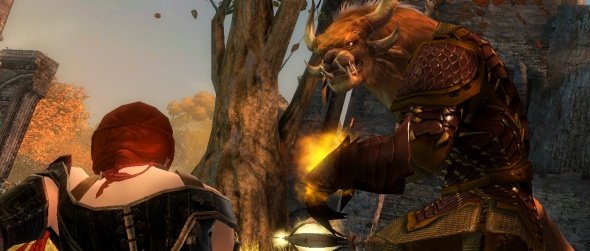Exclusive: Guild Wars 2 to scrap healers and tanks

The tank stands in the front. The healer stands at the back. The damage dealers stand in the middle. So it has been for generations. Guild Wars 2 is making the latest and greatest effort to change that, PC Gamer can reveal, following an exclusive interview with game designer Jon Peters and lead designer Eric Flannum of ArenaNet. The biggest changes? Tanks are gone, healers are gone, the Death Penalty is gone, and you can still kick some arse while you're lying on yours.
Those of you who read Tom's Guild Wars 2 preview on page 50 of our latest issue will already know that every class has a dedicated slot for a healing ability. I asked Jon if they still had a dedicated healing class, like in the first game. He said no. I was like, what? He was like, no, totally.
"There are no dedicated healers that do full healing. Every profession has some form of support to a greater or lesser extent, but none of them enough that they aren't also fighters."

'Support' is Guild Wars 2's word for the job a healer does in other MMOs. They're saying that, in Guild Wars 2, any character can specialise in keeping the party alive. "We don't like sitting around spamming 'looking for healer' to global chat," Jon said. "That feels an awful lot like preparing to have fun instead of having fun."
Eric Flannum elaborated: "What we don't have, and what we didn't want to have, was a character who stands at the back of the party and plays the 'party health bar game' – where they just look at an interface, watch health bars go down, click on a skill, click on those health bars, and that's all they do during combat."
It's a revolutionary attitude towards the stale tradition of Tank in front, DPS in the middle, Healer in back. The traditional image of a healer might be a Priest class in World of Warcraft – white robes, low health, lots of mana, and an armada of healing abilities. Guild Wars 2 aims to propagate a new type of healer: a sort of armoured maniac who hefts his shield to intercept projectiles, strengthens his allies, and who isn't useless when he's caught in a quest area by himself.
"You build your character by picking two different weapon sets. Your weapon sets give you the chance to switch roles in combat. A Warrior can have a bow as one weapon and a mace and a shield as the other. When he's got guys on him he switches to his mace and shield, and when they run, he can switch to his bow and be a different kind of character."
The biggest gaming news, reviews and hardware deals
Keep up to date with the most important stories and the best deals, as picked by the PC Gamer team.

Eric went into more depth about how the mace and shield each conferred unique support abilities very different from what a normal tank might do. Rather than holding aggro, Warriors might block incoming projectiles, or interrupt their charges. "If one of your allies is being chased by a creature; you can use the mace to stun the creature. So the mace provides some control where you can protect allies in that way and that was one of the things we wanted from our support characters."
Still, your health will eventually fall below zero. When that happened in the original Guild Wars, you fell on you back and were unable to act – and in most cases, you'd get stuck with a long-lasting penalty that would reduce your maximum health and energy. That was the first thing on the block when ArenaNet approached this part of the game in Guild Wars 2. "We decided to look into what would make dying a more enjoyable and memorable play experience," Jon Peters told me. They added an intermediary stage in between losing your health and dying – you're hurt, you're bleeding out, but you're not going out without a fight.

